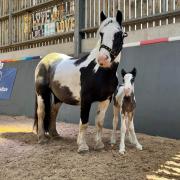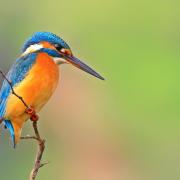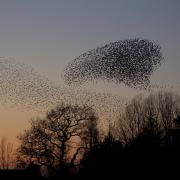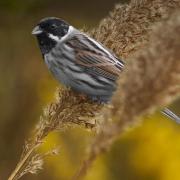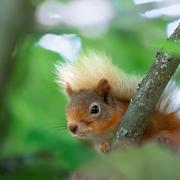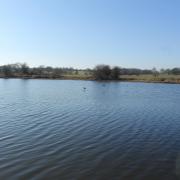In the latest of our series, Nature Moments, we talk to Ben Hargreaves who is The Lancashire Wildlife Trust Plan Bee Project Officer. Local photography by Alan Wright.

Bees have been struggling over the past few decades with two local extinctions of bumblebees.
Many reasons have been put forward for the decline including pesticide use, intensive agriculture, disease, parasites, loss of habitat and loss of food. One major food source for bees is the UK’s wildflower meadows which have plunged by 97 per cent in the past 70 years
There are around 250 types of bee in the UK – 24 species of bumblebees and 225 kinds of solitary bee and honeybees.
Ben said: ‘A world without bees would be very different as many crops and plants require insects to pollinate them. What would a world be like without strawberries, cucumbers, carrots, apples and onions?’

Working with Knowsley, St Helens and West Lancashire councils, and funded by the Cory Environmental Trust and Whitemoss Community Fund, Ben is surveying areas and encouraging the planting of wildflowers. Surveys often involve getting volunteers out onto walks around the region and many are planned for summer.
And Ben is perfectly placed to warn people of the dangers of getting a bit too close to creatures that sting or bite.
He said: ‘Other than the adder, we have few venomous creatures that routinely come into conflict with people. As with the adder, most insect bites from bees, wasps and ants occur when we venture too close to numbers of these insects, accidently step on them or trap them in clothing.
‘The “aculeate Hymenoptera” are a diverse group of insects that include all the bees, wasps and ants. They are part of the wider Hymenoptera that include the sawflies and differ in that most females in the group possess a sting – part of the egg-laying equipment in females.

‘The sting is used primarily for defence of the nest against intruders or perceived intruders. Only female bees, wasps and ants can sting, the males do not possess the sting.’
Ben has been surprisingly sting-free despite his close proximity. ‘I should have been stung, chewed and bitten more than most but, after years of pestering insects in the interests of surveys and biological recording, I have only had occasional stings. Most have occurred when strimming vegetation near to wasp nests and the pheromones, or attack juice as I call it, is very potent.’
Ben witnessed a good example of this seeing his brother get stung repeatedly by hornets – despite frequently submerging himself in the Ionian Sea – after an afternoon spent frenetically battling them with a badminton racket and a stick!
He continued: ‘Most of our eight social wasp species can sting as can solitary wasps and solitary bees. The solitary wasps and bees are often too small to be able to sting humans.

‘Bumblebees can sting but rarely do. I’ve only been stung twice when handling them and the sting is milder than any wasp or bee sting. Honeybee workers have barbs on their sting which often detaches in human skin – leading to the death of the bee.’
And watch out for ants too. Ben said: ‘Formica ants, which include the mound-building wood ants found in Arnside and Silverdale, do not possess a sting. However they do have an acidopore at the base of the abdomen, used to secrete the formic acid from which they are scientifically named. Obviously this burns, so keeping a distance and not disturbing the nest would be wise.’
The strikingly marked “velvet ant” (Mutilla europaea), actually a solitary, parasitic wasp that lays its eggs in bee and wasp nests, is said to have a fairly painful sting. You will only encounter this insect in southern and north eastern England.
Ben said: ‘It also “stridulates” when handled, making a sound reminiscent of grasshoppers or crickets, so you can’t say you weren’t warned.
‘With our comparatively small assortment of bee, wasp and ant fauna we cannot compete with the excruciatingly painful stings of tarantula hawks (spider wasps) or bullet ants – present in the hotter places of the world.’ Thank goodness.
The Wildlife Trust for Lancashire, Manchester and North Merseyside manages around 60 nature reserves covering acres of woodland, wetland, upland and meadow. The Trust has 28,000 members, and over 1,200 volunteers. To become a member of the Trust go to the website at www.lancswt.org.uk or call 01772 324129.
HELP YOUR BEES
• Grow more bee-friendly flowers in your garden. Common plants include borage, bellflower, crane’s-bill, forget-me-not, foxglove, fleabane, honeysuckle, lupin, mint, rosemary, scabious and wallflower.
• Be organic at home and at work. Don’t use neonicotinoid pesticides. Avoid them and urge your local retailer to stop stocking them. Buy organic food or grow your own.
• Encourage your local authority to be bee-friendly, as well as where your children go to school or college, the places you work, play sports and worship.
• You can find more bee advice and information on The Lancashire Wildlife Trust website on the Plan Bee page www.lancswt.org.uk/plan-bee
MY NATURE MOMENT
Sometimes you only realise what you saw much later on. As a child very interested in Natural History, I was familiar with supersized bumblebees that droned like planes and was aware that bees made honey but knew very little else about their habits or why the behaved like they did.
I often wondered why bumblebees would disappear into long, tussocky grass - were they hiding from something or sheltering from the rain? I was aware that bee-like insects - coloured much like the house air brick they disappeared into – were present at the side of the house but again wondered what was going on.
Unlike wasps which sometimes build an obvious, aerial nest it was far from obvious that the bumblebees (probably buff-tailed bumblebees) and mason bees (almost certainly red mason-bees) were “disappearing” into their nests but I realise now, obviously, that this is what they were doing.
Bumblebees often use holes created by small mammals to nest in – and small mammals often exist in high numbers in tussocky grassland – while red mason-bees (and some other mason bees) will nest in a wide range of aerial cavities and can often be found in brick walls.
-Ben Hargreaves, Plan Bee Project Officer




